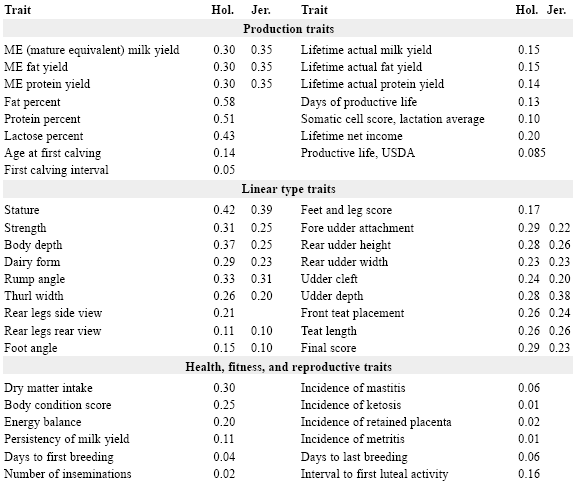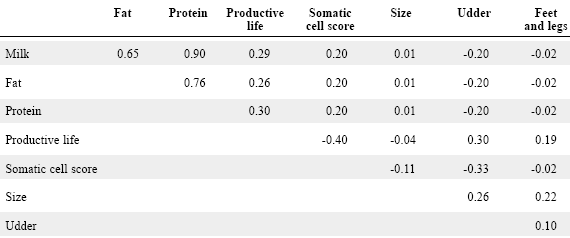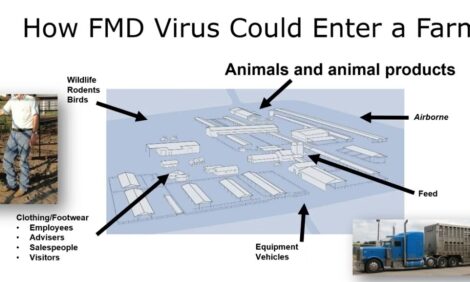



Using Heritability for Genetic Improvement
By Bennet Cassell, Extension Dairy Scientist, Genetics and Management, Virginia Tech.
Concepts surrounding the word "Heritability" (frequently represented by the symbol h2) are among the most important that a breeder of dairy cattle should understand. Heritability applies to a single trait measured on animals in a specific population at a given point in time. Estimates of heritability for a trait can differ between breeds of dairy cattle and may change slowly over time. Heritability is estimated from performance records on animals and pedigree information used to establish genetic relationships between those animals. Heritability helps explain the degree to which genes control expression of a trait. Heritability is used to calculate genetic evaluations, to predict response to selection, and to help producers decide if it is more efficient to improve traits through management or through selection. This guideline highlights definitions and uses of heritability and lists estimates of heritability for several important traits in dairy cattle breeding.
Heritability has several important definitions:
Heritability is a measure of the degree (0 to 100%) to which offspring resemble their parents for a specific trait. This definition can be extended to all genetic relationships such as half sisters sired by the same bull.Heritability measures the strength of the relationship between performance (phenotype) and breeding value (genotype) of an individual animal. Recall that "heritability" applies to a specific trait measured in a specific population of animals at a specific point in time. If the same trait is measured in a slightly different way in some other group of animals, the estimate of heritability can be expected to be different.
Extending definition #2, heritability measures the expected difference in breeding value of an animal for each unit of difference in that animal's phenotype for a trait. Definition #3 is useful in understanding the role of heritability in predicting response to selection.
Heritability is a ratio of causes of variation between animals. Specifically, heritability is the percentage of all differences between animals that is caused by gene effects that transfer from generation to generation. The percentage that remains is NOT caused by transmissible genetic effects. Often, environmental effects are an important part of the remainder.
How is heritability used in breeding programs?
Heritability tells the breeder how much confidence to place in the phenotypic performance of an animal when choosing parents of the next generation. For highly heritable traits where h2 exceeds 0.40, the animal's phenotype is a good indicator of genetic merit or breeding value. For lowly heritable traits, where h2 is below 0.15, an animal's performance is much less useful in identifying the individuals with the best genes for the trait.
Heritability is one important component of the equation used to predict genetic progress from selection to improve a trait. For the most simple form of selection called "mass selection" or selection on phenotypes measured on individuals in a population, that equation is
![]()
The English version of that equation is that genetic progress is the product of intensity of selection times the heritability of the trait under selection times the phenotypic standard deviation of that trait. If any of these three parts is low, genetic progress through selection will be slow. The economic value of the trait may still justify efforts to improve it through selection, as such improvement is a permanent change that benefits all future offspring. Heritability helps the dairy producer decide which traits justify improvement through selection.
Heritability shows how important efforts to improve a trait through improved management or environmental conditions may be compared to genetic selection. Using definition 4 above where h2 is the percentage of differences between animals due to genetic effects, then (1 - h2) is the percentage of differences between animals NOT due to genetic causes that can be transmitted. The higher that percentage is, the more likely it would be that improved management (or some other genetic techniques such as crossbreeding) might be to improve a trait.
How is heritability used to predict genetic merit of a cow?
Suppose a projected milk record on a first calf heifer predicts that she will produce 4,000 lbs. more milk than the other heifers with which she was reared. Table 1 shows that the heritability of milk yield is 30% for Holsteins. Definition 3 says that heritability, 30% in this case, measures the expected change in breeding value for each unit change in phenotype, measured by the 4000 lb. superiority to herdmates. Therefore, we would expect the breeding value for this heifer to be 30% of 4,000 lbs. or 1,200 lbs. In practice, her breeding value would be calculated by more sophisticated procedures in the USDA animal model system, but heritability would be used just like this example to decide how conservative to be about her breeding value given that she has such a fine herdmate deviation. If heritability of milk yield was 35% as is appropriate for non-Holstein breeds, the estimate of breeding value would have been slightly less conservative, 1,400 lbs. If milk yield were only 10% heritable, then 90% of differences between heifers in milk yield would have been of non-genetic origin, and this heifer's breeding value would be estimated at only 400 lbs. based on the same yield deviation.What should producers do about traits with low heritabilities?
Heritability can tell us how closely genetic merit follows phenotypic performance, but it tells us nothing about the economic value of better performance. Some traits with low heritabilities, such as the survival and fitness traits in Table 1, have low heritabilities but high economic value. Other traits, like stature, are moderately to highly heritable, but have insufficient economic value to be given much emphasis in selection programs. Producers should select to improve traits with low heritabilities when economic circumstances justify the attention. In addition, lowly heritable traits of substantial economic value should always be targeted for improvement through better environmental conditions.The dairy industry is increasingly interested in genetic improvement of health, fitness, survival, and reproductive traits. Milk production is more heritable than these traits, and genetic gains in milk production for the last 30 years have been substantial. Perhaps part of the reason for increased emphasis on equally valuable traits of lower heritability has been the genetic progress made in milk production. Many farmers feel that their cows have more genetic ability to produce than can be utilized efficiently on many dairy farms. The relative economic value of the fitness traits and milk production appears to have changed and selection objectives will change as well.
Traits of low heritability can be selected for successfully by using aids to selection such as progeny testing and multiple records on individual animals. Standardized environmental conditions can actually increase heritability by reducing the non-genetic differences between animals. Modern milking facilities, large herds, better nutrition, and skilled management personnel have all increased the opportunity for genetic improvement of health, reproductive, and fitness traits.
Heritabilities for important traits in dairy cattle breeding:
Table 1 contains some recent estimates of heritabilities for traits of interest to dairy cattle breeders. Holsteins and Jerseys represent separate populations, so separate estimates of heritability are listed where available. Genetic evaluations are available nationally for the production traits, for productive life, somatic cell score, and the linear type traits. In the future, genetic evaluations may become available for some of the remaining traits as well. Health and fitness traits are increasing in economic importance to dairy herd managers. Genetic evaluations may be forthcoming as economic conditions continue to evolve and useful sources of performance data are developed or exploited for these traits.The most highly heritable traits in Table 1 are the component percentages for fat and protein. Close behind is the estimate of heritability for stature, one of the most objectively measured linear type traits. Traits with the lowest heritabilities are disease incidence traits and the standard DHI measures of reproductive performance, days to first breeding or number of inseminations. The last entry in Table 1 is an estimate of heritability of 0.16 for a relatively new measure of fertility, interval to first luteal activity. This trait is measured by progesterone analysis of milk samples during the first few weeks of lactation. The expense and labor of such measurements using today's technology restrict its use to research trails, but in the years to come, we may rely more heavily on such information to identify more fertile cows or progeny groups. Heritability of interval to first luteal activity is higher than for interval to first breeding because cow behavior, missed heats, or management decisions have less effect on total variation between cows.
Genetic correlations measure relationships between traits:
Genetic correlations have always been an important part of carefully constructed breeding programs, but the concept of a genetic correlation is perhaps even less well understood than the concept of heritability. Part of the reason is that genetic correlations are difficult to estimate. Only within the last 10 to 15 years have most scientists had access to the computing power necessary to make good estimates of genetic correlations. Consequently, we know much more today about genetic correlations between economically important traits than we knew when the animal model was introduced to the dairy industry in 1987. Genetic correlations can be positive or negative and range from -1.0 to 1.0, whereas heritability is always positive and ranges from 0.0 to 1.0. Genetic correlations tell us how pairs of traits "co-vary" or change together. When genetic correlations are close to zero, different sets of genes control each trait and selection for one trait will have little effect on the other. As genetic correlations become different from 0.0, then more of the same genes affect both traits. Selection for one trait will increase the other if the genetic correlation is positive and decrease it if the genetic correlation is negative.Several of the traits in Table 1 were combined into a single selection index called Net Merit in August 2000 (see Dairy Guideline 404-088 for details). The traits in Net Merit are controlled by some of the same genes, and are thus genetically correlated. Estimates of those genetic correlations are shown in Table 2. Restating the definition in the previous paragraph, selection to improve any single trait will also change any trait to which it is genetically correlated because the genes controlling the two traits overlap to some degree. Such a correlated response is responsible for deeper udders or wider front teat placement on higher producing cows. A correlated response to selection for higher milk yield is also responsible for the increased appetite of cows with modern genetics compared to cows from 40 years ago.
Genetic correlations from about 0.6 to 0.99 between two traits mean that those traits will progress strongly in the same direction if selection is practiced for one trait of the pair. Genetic correlations of -0.2 to +0.2 between two traits mean that selection to change one of the traits will have little effect on the other trait. Negative genetic correlations, say from -0.6 to -0.99, mean that selection to increase one trait will result in a reduction in genetic merit for the second trait. Genetic correlations in the middle ground of +/- 0.2 to 0.6 mean that slow change will occur. Sometimes such correlations indicate serious, long term economic problems or opportunities to improve traits that are difficult or expensive to measure. Sometimes such correlations can be ignored in a breeding program.


Conclusions:
Heritability is one of the most important concepts in animal breeding. There are several working definitions, as heritability is used to help plan breeding programs, determine management strategies, estimate breeding values of individual animals, and predict response to selection. In general, traits related to fertility, fitness, health and survival have low heritabilities of less than 0.15. Production traits like milk or protein yield are moderately heritable, with h2 from 0.15 to about 0.40. Product quality traits such as fat and protein percent tend to have the highest heritabilities, above 0.40. The heritability of a trait is not the deciding factor in whether to include it in a genetic improvement program, as the economic value of even lowly heritable traits demands that they be changed by selection. Accuracy of selection for traits with low heritability can be improved with multiple measurements on an individual, use of pedigree information, and increased progeny group sizes. Molecular genetic techniques such as genetic markers will become more important in helping producers change all economically important traits, though the opportunity to improve accuracy of selection will be greater for lowly heritable traits. Changes currently underway in the dairy cattle breeding industry will likely result in the use of more traits with low heritabilities in selection decisions than have been used in the past.References:
Metabolic stress in dairy cows. 1999. J. D. Oldham, G. Simm, A. F. Groen, B. L. Nielsen, J. E. Pryer, and T. L. J. Lawrence, editors. Occasional Publication No. 24, British Society of Animal Science, Edinburgh, Scotland.
Pearson, R. E., W. E. Vinson, and T. R. Meinert. 1990. The potential for increasing productivity through selection for increased milk and component yields. Proc.
4th World Congr. Genet. Appl. Livest. Prod. Edinbburgh, Scotland. XIV: 104-113.
Smith, L. A. B. G. Cassell, and R. E. Pearson. 1998. The effects of inbreeding on the lifetime performance of dairy cattle. J. Dairy Sci. 81: 2729-2737.
VanRaden, P M. and G. R. Wiggans. 2001. Revised methods to compute multitrait productive life. AIPL Production Research Report.
November 2001



